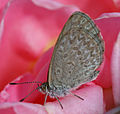| Indigofera australis | |
|---|---|
 | |
| Scientific classification | |
| Kingdom: | Plantae |
| Clade: | Tracheophytes |
| Clade: | Angiosperms |
| Clade: | Eudicots |
| Clade: | Rosids |
| Order: | Fabales |
| Family: | Fabaceae |
| Subfamily: | Faboideae |
| Genus: | Indigofera |
| Species: | I. australis |
| Binomial name | |
| Indigofera australis | |
 | |
| Synonyms | |
Indigofera australis, the Australian indigo or Austral indigo, is a species of leguminous shrub in the genus Indigofera (family Fabaceae). [1] The genus name Indigofera is Neo-Latin for "bearing Indigo" (Indigo is a purple dye originally obtained from some Indigofera species). The specific epithet australis, from the Latin, means not “Australian” but "southern", referring to the geographical distribution of the species. [2]

